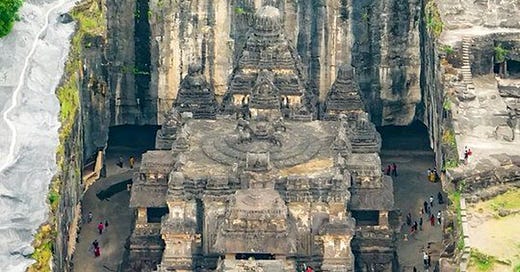Chapter 2: The King’s Dream
The year was 756 CE. Monsoon clouds brooded over the Deccan plateau, veiling the sky in deep, moody grays. In the citadel of Elapura, King Krishna I of the Rashtrakuta dynasty stood alone in his chamber, silhouetted against a brass lamp whose flickering flame cast elongated shadows on stone walls carved with sacred motifs. The air smelled of sandalwood and old iron—an aura befitting the bearer of an empire.
That night, the king did not sleep easily. The burdens of kingship weighed heavily on his soul—petty wars to the north, rebellious vassals to the south, and the relentless march of time that even royalty could not defy. Yet, it was not anxiety that stirred his spirit most, but a longing—an aching desire to leave behind a legacy that would echo across centuries.
As the oil in the lamp dimmed and the wind whispered through the jharokhas, the king finally collapsed into slumber. But what awaited him there was no ordinary dream.
He stood on a vast plateau beneath a velvet sky filled with stars that pulsed like heartbeats. Before him towered a mountain of black basalt, uncarved, unmarked, and ancient as time itself. From its summit flowed a luminous stream of silver light, cascading not with water but with syllables—Sanskrit mantras that shimmered and sang as they fell. Om Namah Shivaya… Om Namah Shivaya…
Then, from the heart of the rock, a figure began to emerge—not carved, not built, but revealed. It was Lord Shiva himself, majestic and serene, seated upon Mount Kailasa, flanked by Nandi, Parvati, and celestial beings. His third eye opened and locked with the king’s gaze.
“You seek immortality, O king,” the voice said, echoing in all directions. “Then carve not a monument of pride, but a vessel for the eternal. Bring forth Kailasa from stone—not for your name, but for Dharma. Not to rule the earth, but to awaken the skies.”
Lightning cracked through the dream. The mountain trembled. And then—the king awoke, heart pounding, robes soaked with sweat, the echo of divine command still ringing in his ears.
He summoned his ministers before dawn. The royal court, draped in half-light, watched as their sovereign—usually so composed—spoke with fire in his voice and awe in his eyes.
“The gods have spoken,” he said. “We shall not build a temple upon the earth. We shall free it from the mountain, as if the gods themselves placed it there long ago, hidden. Let all who come after know this was not a work of man’s ambition, but of divine obedience.”
The court was silent. Then murmurs rose—of madness, of reverence, of impossible dreams. But none dared oppose the king, for there was something in his voice that transcended politics: a tremor of the sacred.
That very day, royal scribes were ordered to draft the first plans. Artisans were summoned from across the subcontinent—master stonecutters from Gujarat, engineers from Tamilakam, and sculptors who traced their lineages to the very architects of Dwaraka.
But no one knew how it could be done. To carve a free-standing temple from a single mountain—top-down—was unheard of. Even the oldest shilpa shastras had no instruction for such a feat.
Still, the king was undeterred. He knew this was not merely architecture. It was a revelation. It was the chisel of the gods guiding the hands of men.
And so began the impossible task: to bring heaven to earth, not by building up but by carving away.





I wouldn't mind awakening the skies...